Wanderbus is a relatively new travel company offering hop-on hop-off itineraries in Ecuador. It’s a more in-depth tourist experience than simply traveling in a straight line from A to B. Long ago I did a fixed itinerary bus trip in Europe. But there was no freedom to stay longer in your favorite places. Thus, enter the alternative to fixed itineraries and public buses – the Wanderbus.
We’ll begin this post by first discussing the Wanderbus Itinerary, and next, weigh a few pros and cons of traveling with Wanderbus in Ecuador.
Contents
The Wanderbus Itinerary
Day 1 – Quito to Baños
On the first day, the bus picks you up 6h10am at Plaza Foch in Quito. I didn’t get enough sleep the previous night, mistakingly thinking I’d sleep more on the bus. Don’t get me wrong, the bus was quite comfortable – 1 extra seat free for everyone. But there are frequent bathroom and excursion stops – it’s not simply a long 4 or 5-hour ride where you’d sleep throughout.
The first stop was at a typical Ecuadorian dairy farm. Here, we get some breakfast. Plus, we are given the opportunity to try and milk a cow.
Next, we leave to Cotopaxi Volcano, The previous day there was a mudslide and thus the park was closed. Today we’re lucky since it’s open again. However, once we arrive, there’s a thick mist over the volcano, thus clear photos are not possible. Unfortunately, at Cotopaxi, there is no guarantee of good weather. We go for a walk anyway, and the tour guide introduces us to a few of the local plants, e.g. Ecuador’s national flower which helps with breathing at high altitude.
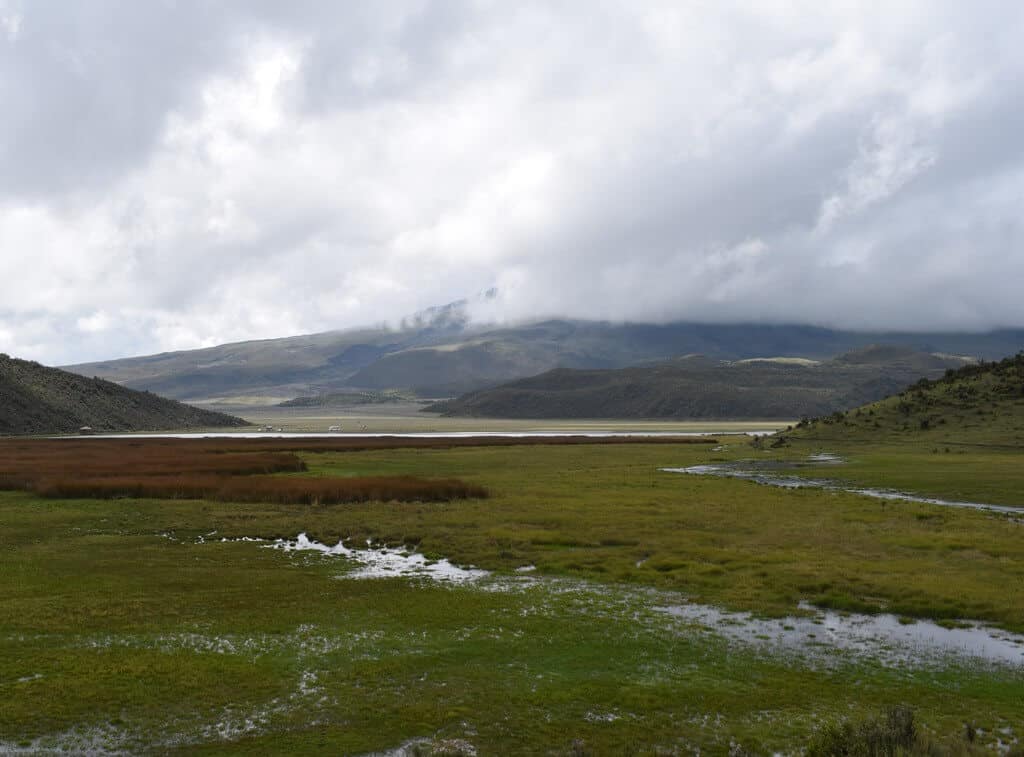
After Cotopaxi, we get lunch at Pujili, a small colonial town in the countryside. There is a choice of chicken, beef or vegetarian. If you ask extra salad instead of the white rice, this can definitely be considered a nutritious meal.
Now we head to the Volcano-lake at Quilotoa. There is the option to hop off and stay overnight, then going horseriding, boating on the lake, or hiking. However, everyone on the bus decides to simply take a few photos, then travel on to Baños.

Finally, after a day full of tourist activities, we arrive around 7h30pm in central Baños. Tired, I immediately fall asleep after checking into my hotel.
Day 2 – Baños to Cuenca
After spending a few days enjoying nature around Baños, I decide to move on to Cuenca. Day 2 with Wanderbus was another early start (6h45 am). Initially, it’s a smooth ride to Riobamba’s market.
At the market, there are ten vendors selling roasted pork, and ten more selling Llapingachos. Most of us choose Llapingachos (potato cakes) with egg, avocado, and salad – the price only $2. I also grab a fresh juice mix (alfalfa, mora, papaya, and guava) for $1,25.
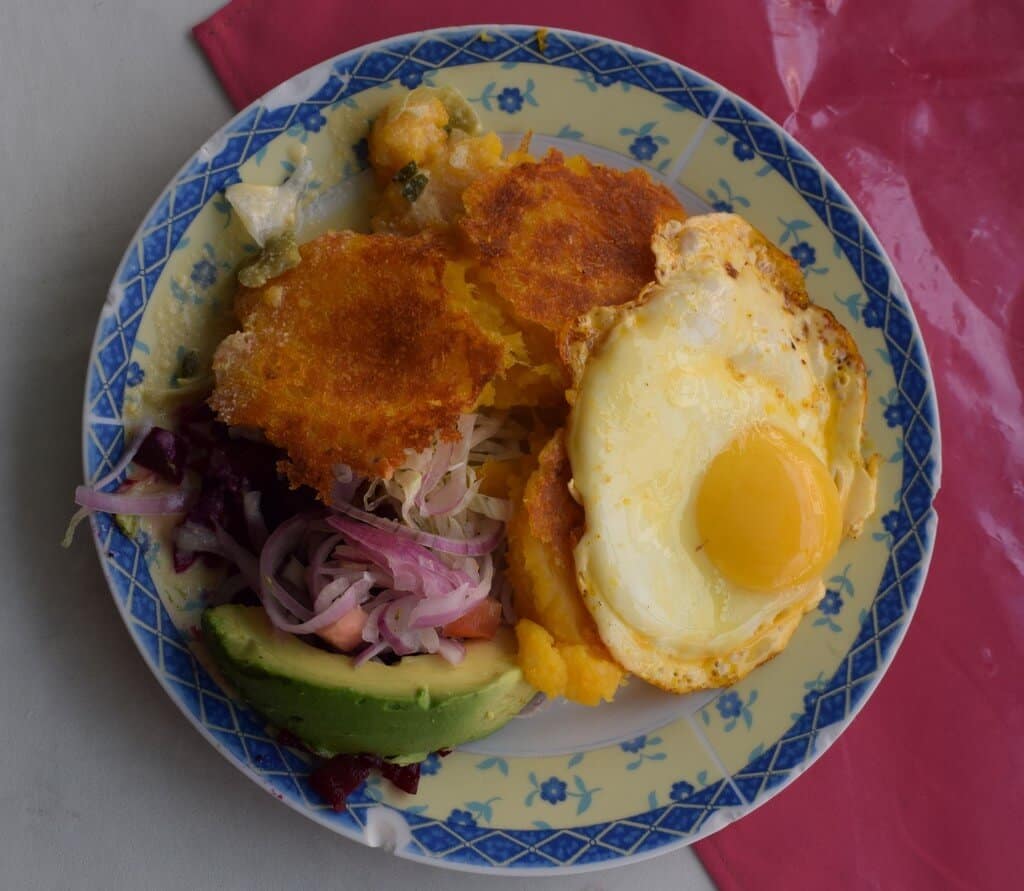
For an authentic local breakfast, Riobamba’s market is a good stop. Now we drop off two passengers, while the rest continue on to Ozogache.
If you like unusual landscapes such as mountains and lakes, you’ll enjoy Ozogache (main photo above). However, my own interest lies more in Ecuador’s regional food than in the landscapes. Lunch was locally-caught trout with home-cooked plantain and traditional corn – 100% natural with no additives. The price of this optional meal was $5, and well worth it.
The next “stop” is the Aluasi train ride, but no-one on the bus chose this option. Thus, it’s a long ride from Ozogache to Cuenca.
The road is rather uneven, with continuous twists and turns. Due to the nature of the road (and not due to any fault of Wanderbus), it’s very difficult to sleep or even read during this stretch of the itinerary. Day 1 was a much smoother bus ride, but if you want to get from Baños to Cuenca by bus, this is the only way to go.
Finally, we arrive in Cuenca. It’s a city that, similar to e.g. Santiago in Chile, feels quite First World in the daytime, by Latin-American Standards. I stay for a few days exploring the colonial streets and local expat life. Then onto the next destination.
Day 3 – Cuenca to Montañita
Departing from Cuenca, unlike day 2, the breakfast was not as inspiring. Fruit juice and coffee, along with eggs and bread. However, the scenery at Cajas National Park makes up for breakfast. Beware the sudden ice-cold temperatures at this high altitude.

As we drive away from Cuenca, the road gets much smoother. In a few hours, we arrive at the most interesting excursion of this trip – the chocolate farm in Guayas province, close to Guayaquil. Suddenly the temperatures are also much warmer. What an experience going from freezing to tropical heat in a matter of hours.
Along with walking through Cacau plantations, we prepare traditional hot chocolate straight from the Cacau beans. Everyone in the group takes part in roasting, dehusking the beans, and milling it into a paste. Next, there’s a gourmet lunch for $5. It’s a well-presented meal (but for a man – too small a portion).
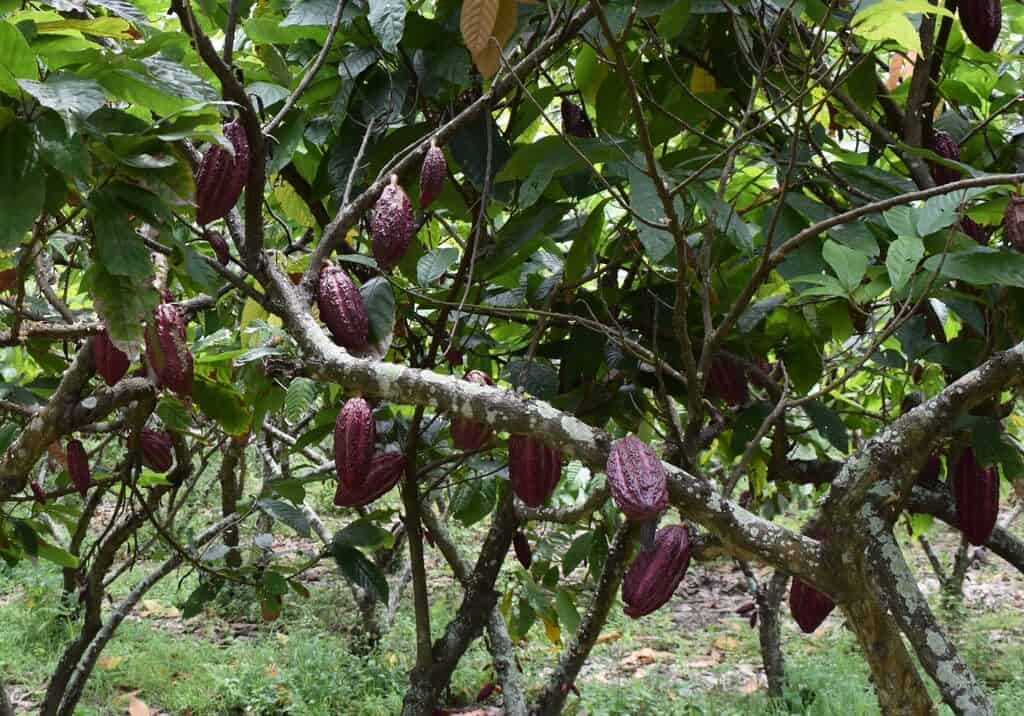
At the next stop, I hop off at Guayaquil for a couple of nights. It’s the largest city in Ecuador, but not really touristic. Still, I was curious if I’d like it more than Quito. Conclusion: Quito is better. Many travelers prefer to skip Guayaquil – continuing on to better places after being dropped off next to the bus station.
After a day or two, I move on to Montañita. For this leg of the trip, we stop at an authentic Ecuadorian hat-weaving factory. Fascinating to see locals weave the traditional Ecuadorian hat from 100% natural fibers.
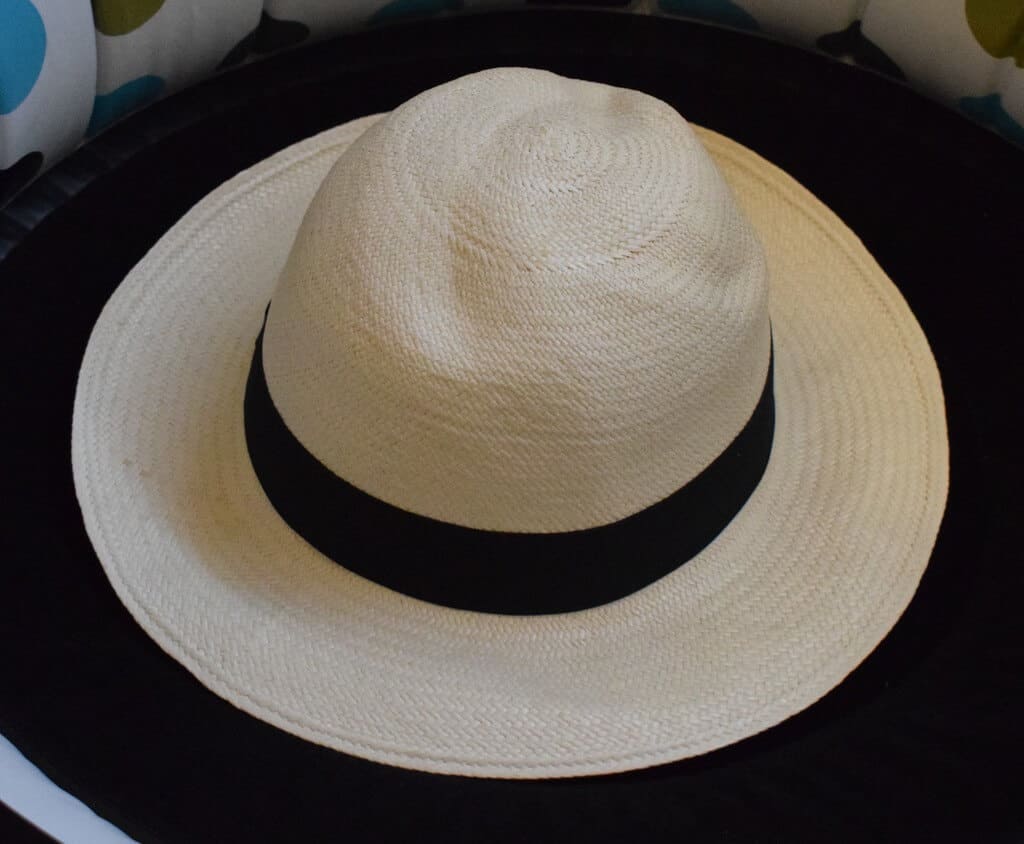
Day 4 – Montañita to Quito
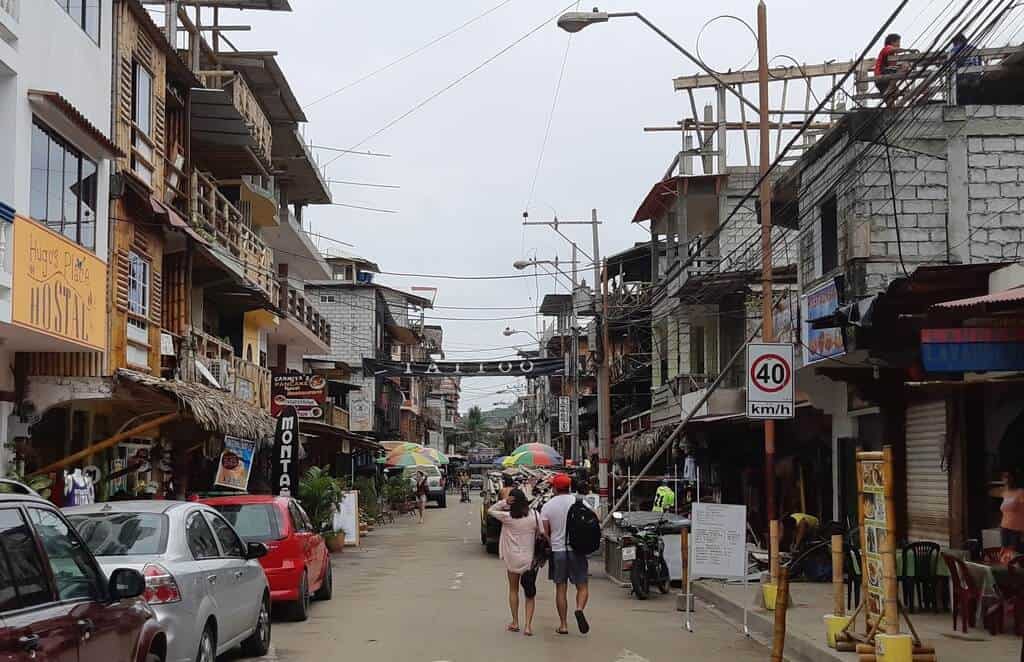
After chilling at the beach for a few days, I hop on 7 am in Montañita. We pick up a few older travelers at Puerto Lopez – a more tranquil coastal town. Next, we stop for breakfast at a sea-side “restaurant” and enjoy a typical local plantain meal. Good choice, since it’s not simply eggs and toast.
Lunch was somewhere in the highlands – a quality meal ($5) consisting of rice, salad, and prawns (although other choices were also available), as well as a Mora exotic fruit smoothie ($1).
Day 4 isn’t as touristic as the other days in the itinerary. Especially since its a long journey from Montañita to Quito. Plus, there isn’t that much for the tour guide to comment on during this last stretch of the road. I arrive 7 pm at my Airbnb in Quito, after being picked up 7 am that morning in Montañita. Twelve hours is a long enough day.
Best and Worst with Wanderbus
Best Destination: Cuenca
Least Favorite: Guayaquil
Best Excursion: Cacau Farm
Least Favorite: Dairy Farm (Disclosure: I don’t consume dairy)
Best Weather: Montañita
Worst Weather: Quito
Stop with Best Value For Money: Cuenca
Least Value For Money: Montañita – since it’s a tourist village. Yet, there are cheap backpacker options if you’ll tolerate high noise levels e.g. at Selina Hostel. Otherwise, stay further outside of the center.
Favorite Meal: The Trout at Ozogache, with Choclo maize and Platano.
Least Favorite Meal: The first breakfast at the dairy farm can be improved. Also, a larger portion at the Cacau farm.
The Best Place to Boost Fitness: Baños has a few good gyms, along with the saunas and steam baths (e.g. at Eduardo’s). Plus, there are plenty of outdoor activities in nature.
Worst For Fitness: In Montañita there was only one very small gym, along with one or two yoga studios for around $8 per class (not cheap by Ecuadorian standards).
Benefits of Traveling with Wanderbus
- English proficient tourist guides make the trip more interesting.
- You don’t stress about your luggage during the trip.
- You see much more than with a public bus.
- Side excursions like the Cacau farm would otherwise be difficult to experience.
- Less planning and admin required – buy one ticket for everything.
- It’s a social way of traveling.
- You avoid bus terminals. Pickup points are central, apart from the Guayaquil Airport/bus-station stop, which was a $4 taxi ride away from my accommodation.
- You can’t travel directly to Montañita with a public bus (although you could go to e.g. Salinas instead).
- Choose at which places you want to hop-off or hop-on.
Suggestions for Improvement
- Some meals can be improved. If you’re into wellness travel, white bread rolls, eggs, and cheese aren’t the best breakfast (although healthy fruit juice is usually included).
- In the web interface, there is the option to select your pickup point on a specific date. Then, there is another option for requesting changes to your itinerary. I see this as doing the same thing twice. You should be able to simply select your pickup point while choosing a date, and automatically, on their system should be a list of travelers who chose that specific date and pickup point. They do provide an email address and WhatsApp number to confirm itinerary changes. I recommend making these changes during regular business days when staff is in the office, and not public holidays or weekends.
- Slightly better buses: I’ve definitely experienced less comfortable buses than the Wanderbus. However, an older traveler didn’t like squeaky noises inside the bus en route to Cuenca from Banos. While a girl suggested the inter-city buses were more modern than Wanderbus. I didn’t verify this since I only traveled with Wanderbus.
More Tips
- Go to bed early the previous night. The better rested you are, the more you’ll enjoy the trip. Although it’s decent for sitting, Wanderbus is not as great for sleeping. These buses were designed for day trips and not for overnight travel (Wanderbus is not an overnight travel company).
- In Ecuador, weather temperatures fluctuate a lot. It can go from icy-cold to tropical heat within 2 hours. Thus, unless maybe when it’s Summer, bring a warm jacket along on every leg of the trip.
- If you want a vegan/vegetarian meal, or you have any other special dietary requirement, tell the tour guide and they’ll organize something.
- I only wanted to stay 3 nights in Montañita, but due to bus schedules, had to stay 4. However, this can be avoided with better planning.
Conclusion
Wanderbus is a simplified but in-depth way to see mainland Ecuador. Everyone has a unique motivation for traveling. Some might enjoy the laid-back surfing vibe at Montañita, while others prefer the adventure activities of Baños. Or as an older traveler, maybe you want to explore the expat life in Cuenca. While for those who loves landscapes, Ozogache and Cajas are great. But to explore natural foods like dark chocolate, the Cacau farm is more interesting. Thus there’s something for everyone.
Many travelers avoid mainland Ecuador and simply go to the Galapagos Islands. They may be worried about safety, or they don’t know exactly where to go. Thus by hopping on to the Wanderbus, you eliminate a lot of these concerns and see the rest of Ecuador as well. Plus, although mainland Ecuador is less touristic than the Galapagos, it’s definitely much more affordable.
I received a discount from Wanderbus on my bus pass, in exchange for writing this article. But this did not influence my impartiality in this blog post. Check out their website here.
Do you have any further questions on traveling with Wanderbus? Or a few tips for other travelers visiting Ecuador? Post your questions and comments below!
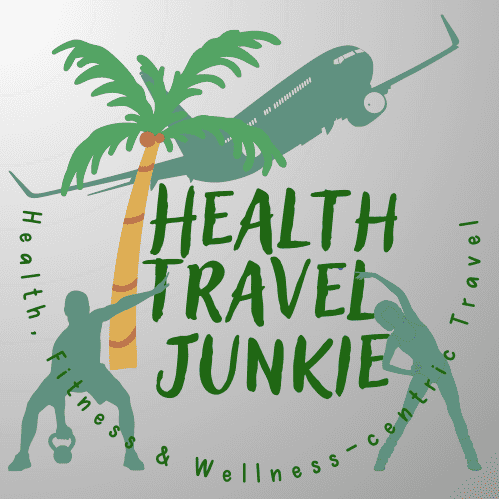
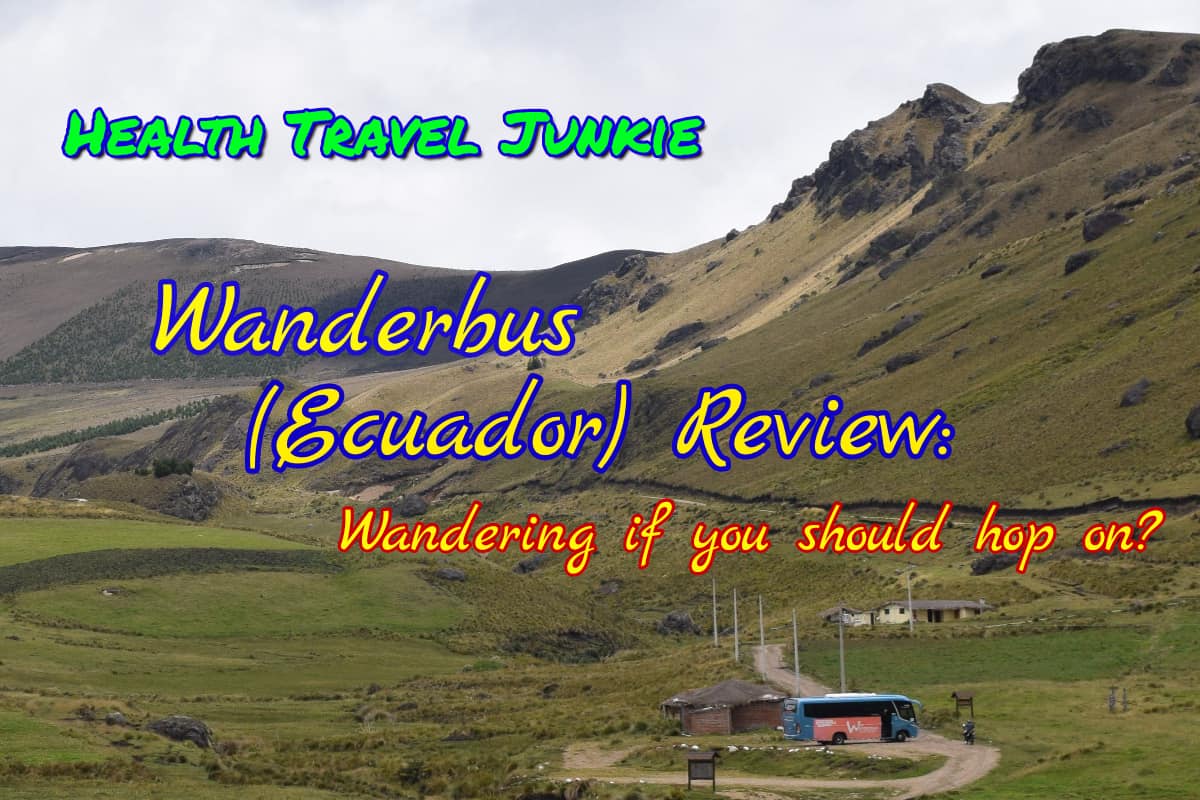
Is there a direct route from Quito to Banos? We wanted to start our trip there due to the Lower elevation and then more on to Cotopaxi and Quilotoa afterwards. Is this possible?
You can go from Quito to Banos. But the Quito-Banos route includes visiting Cotopaxi and Quilotoa (can stay overnight optionally).
Yes, Banos is lower elevation. You will acclimatize better to the altitude that you’ll experience at e.g. Cotopaxi, if you’re in Quito, rather than in Banos. As Quito is 1000m higher than Banos.
Thus, for me it would make more sense to go from Quito to Cotopaxi and Quilotoa, rather than going from Banos to those two attractions. Because its a smaller altitude gap, and thus easier to acclimatize.
Quito Altitude: 2850m
Banos: 1820m
Cotopaxi: 4600m (Summit: 5897m)
Quilotoa: 3914m
Also contact Wanderbus directly, as I did the journey with them in 2019, and maybe there’s a few small changes since then.
Is there an option to have them help with hotels or is this on your own? If on your own, did you book ahead of time or as you went?
I prefer to do this myself, but they can help you with hotels, if you want.
I booked a few days ahead of time. E.g. I went to Banos, then when I wanted to leave Banos after 3 or 4 days, I booked for Cuenca one or two days ahead of time.
However, if you go in the most busy tourist season, it would probably be better to book longer ahead of time.